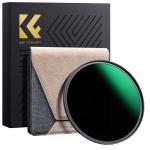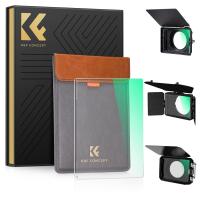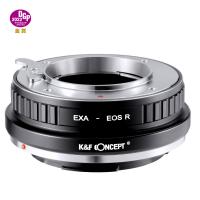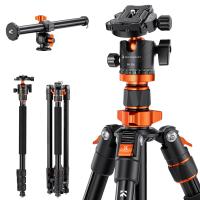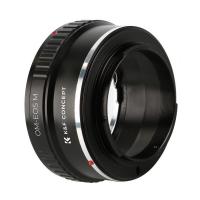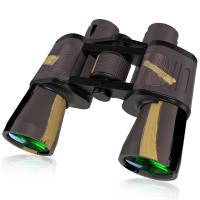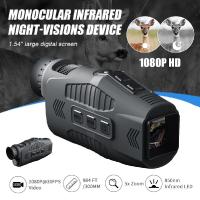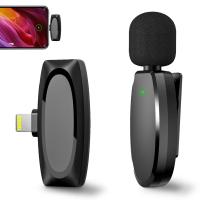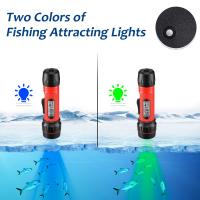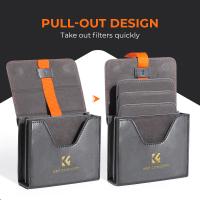Reviews
Impressive optical quality, even in backlight, with only a slight color shift.
I tested the K&F Concept Nano-X PRO series ND1000 67mm neutral density filter with the Sony A7RII on a Sony SEL-20F18G.
The design of the K & F is a slim filter. This can prevent vignetting in an extremely wide angle, but the slim frame makes handling difficult when screwing and screwing on. More, as easy to handle, I would not turn on the filter. In any case, it should be positively mentioned that the filter has a threaded socket at the front, so that several filters can be screwed one behind the other. In theory, you could also use several neutral density filters in series. Depending on the type, the lens hood and lens cap can also be fitted. The filter comes in a high-quality, sturdy bag with magnetic closure. As a little gimmick, the manufacturer also includes a microfiber cloth for cleaning.
The thread can be unscrewed cleanly. The glasses come from the Japanese house Asahi Glass and appear to have a high-quality finish. I noticed a slight color deviation into reddish. During my tests, however, I found the slightly warmer color temperature appealing. You could easily compensate for this during post-processing. Since my used lens is not susceptible to lensflares, I was happy that there was no deterioration with the filter on. The filter reduces incoming light almost exactly by around 10 stops. The filter only allows approximately 0.01% of the incoming light to pass through. ND1000 means that in order to achieve the same result, we have to expose 1000 times longer than without a filter. This allows you to achieve extremely long exposure times of several seconds to minutes in daylight. I recommend that beginners print out a table to quickly find the right exposure time.
In my attached pictures, you can see the result even with extreme backlight, both with and without filters. I could hardly notice any differences in quality here. With and without filters, there were neither more nor fewer lens flares. These only appeared in other places in the picture. The white balance was set consistently for all shots, manually to daylight, and all other settings were set manually for direct comparison, with the exception of shutter speeds, of course. Here you can see the only slight color shift into something reddish. I was only able to notice a loss of sharpness after 600% magnification, if at all.
So far, I haven't had K&F Concept on my screen in this price range. The price is, of course, an announcement and should scare off amateur photographers for now. However, you don't want to reduce the quality of a lens in the four-digit price segment with an inferior filter, so the investment can also be worthwhile for ambitious amateurs. Because of the impressive optical performance, I give it the full five stars.
The design of the K & F is a slim filter. This can prevent vignetting in an extremely wide angle, but the slim frame makes handling difficult when screwing and screwing on. More, as easy to handle, I would not turn on the filter. In any case, it should be positively mentioned that the filter has a threaded socket at the front, so that several filters can be screwed one behind the other. In theory, you could also use several neutral density filters in series. Depending on the type, the lens hood and lens cap can also be fitted. The filter comes in a high-quality, sturdy bag with magnetic closure. As a little gimmick, the manufacturer also includes a microfiber cloth for cleaning.
The thread can be unscrewed cleanly. The glasses come from the Japanese house Asahi Glass and appear to have a high-quality finish. I noticed a slight color deviation into reddish. During my tests, however, I found the slightly warmer color temperature appealing. You could easily compensate for this during post-processing. Since my used lens is not susceptible to lensflares, I was happy that there was no deterioration with the filter on. The filter reduces incoming light almost exactly by around 10 stops. The filter only allows approximately 0.01% of the incoming light to pass through. ND1000 means that in order to achieve the same result, we have to expose 1000 times longer than without a filter. This allows you to achieve extremely long exposure times of several seconds to minutes in daylight. I recommend that beginners print out a table to quickly find the right exposure time.
In my attached pictures, you can see the result even with extreme backlight, both with and without filters. I could hardly notice any differences in quality here. With and without filters, there were neither more nor fewer lens flares. These only appeared in other places in the picture. The white balance was set consistently for all shots, manually to daylight, and all other settings were set manually for direct comparison, with the exception of shutter speeds, of course. Here you can see the only slight color shift into something reddish. I was only able to notice a loss of sharpness after 600% magnification, if at all.
So far, I haven't had K&F Concept on my screen in this price range. The price is, of course, an announcement and should scare off amateur photographers for now. However, you don't want to reduce the quality of a lens in the four-digit price segment with an inferior filter, so the investment can also be worthwhile for ambitious amateurs. Because of the impressive optical performance, I give it the full five stars.
01/11/2022
Top Bestselling Products
C$23.04 C$15.00
C$5.00
Related Articles
